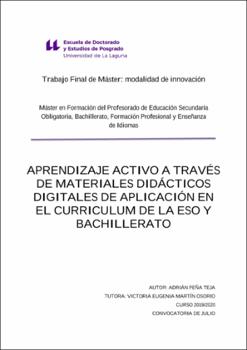Aprendizaje activo a través de materiales didácticos digitales de aplicación en el curriculum de la ESO y Bachillerato
Autor
Peña Teja, AdriánFecha
2021Resumen
El diseño de materiales didácticos digitales es clave para la elaboración de las
situaciones de aprendizaje. En la realidad que nos hemos visto inversos debido al
confinamiento por la pandemia del COVID-19, nos hemos visto obligados a poner en
práctica dichos recursos, es más, se ha podido comprobar que si se implantan de manera
adecuada dan mejores resultados que las herramientas convencionales. En el presente
estudio se llevó a cabo una situación de aprendizaje “Especies exóticas invasoras, EEI”
en el IES Tegueste para alumnado de 1º, 3º, 4º de ESO y 1º de bachillerato de la asignatura
de Cultura científica. Debido a la presencia de alumnado con TEA (Trastorno del
Espectro Autista) y TDAH (Trastorno de Atención con y sin Hiperactividad), la situación
de aprendizaje atendió a esta diversidad sin la necesidad de una adaptación curricular.
Aplicando un método de enseñanza como es el aprendizaje activo junto con una técnica
de aprendizaje, como es la gamificación, se consiguió atender a esta diversidad y, por lo
tanto, la inclusión de todo el alumnado. Por otro lado, la teledocencia ha puesto de
manifiesto las limitaciones socioeconómicas de una parte del alumnado, brecha digital.
También el profesorado se ha visto limitado en cuanto a competencias digitales se refiere,
afianzando el hecho de la necesidad y utilidad que tienen las TACs (Tecnologías del
Aprendizaje y la Comunicación) en el proceso de enseñanza aprendizaje. The design of digital teaching materials is key to the development of the learning
situations. In the reality in which we have been reversed due to the confinement related
to the COVID-19 pandemic, we have been forced to apply these resources; moreover, it
has been verified that if they are implemented properly they give better results than the
conventional tools. In the present study, a learning situation “Invasive exotic species,
EEI” was executed at the IES Tegueste for students of 1st, 3rd, 4th of ESO and 1st of
Baccalaureate of the subject of Scientific Culture subject. Due to the presence of students
with ASD (Autism Spectrum Disorder) and ADHD (Attention Disorder and without
Hyperactivity), the learning situation attented to this diversity without the need for a
curricular adaptation. In addition, applying by a teaching method such as active learning
with a learning technique, like gamification, it was possible to attend to this diversity and,
therefore, the inclusion of all the students. On the other hand, teledoaching has
highlighted the socioeconomic limitations from one part of the student body, digital
divide. Teachers have also been limited in terms of digital skills, reinforcing the fact that
TACs (Learning and Communication Technologies) are necessary and useful in the
teaching-learning process.





